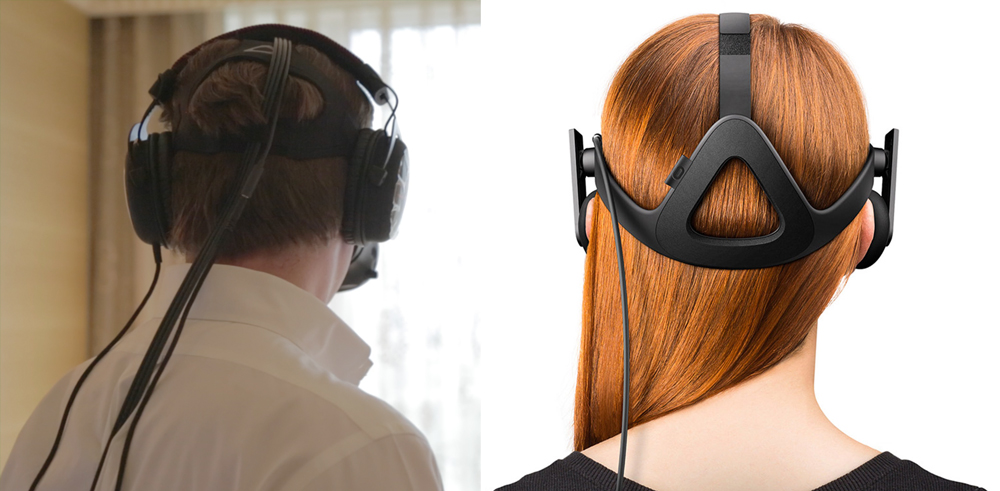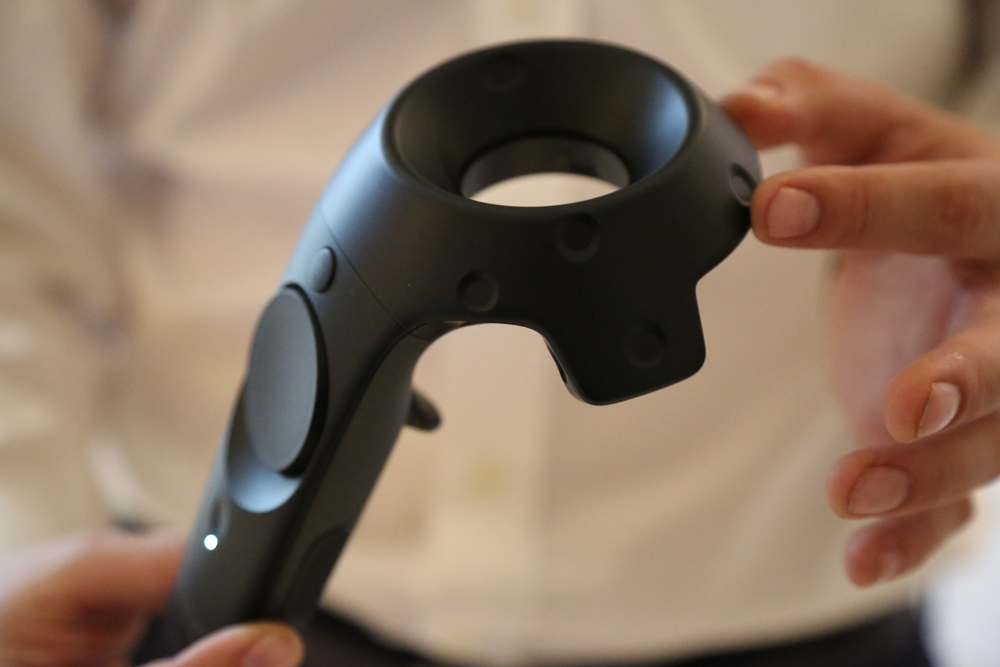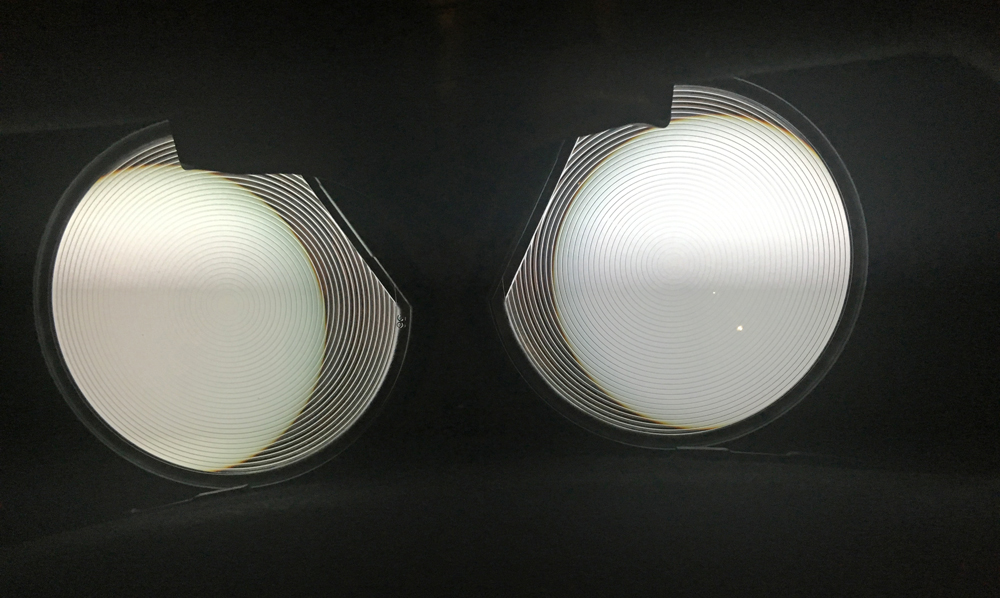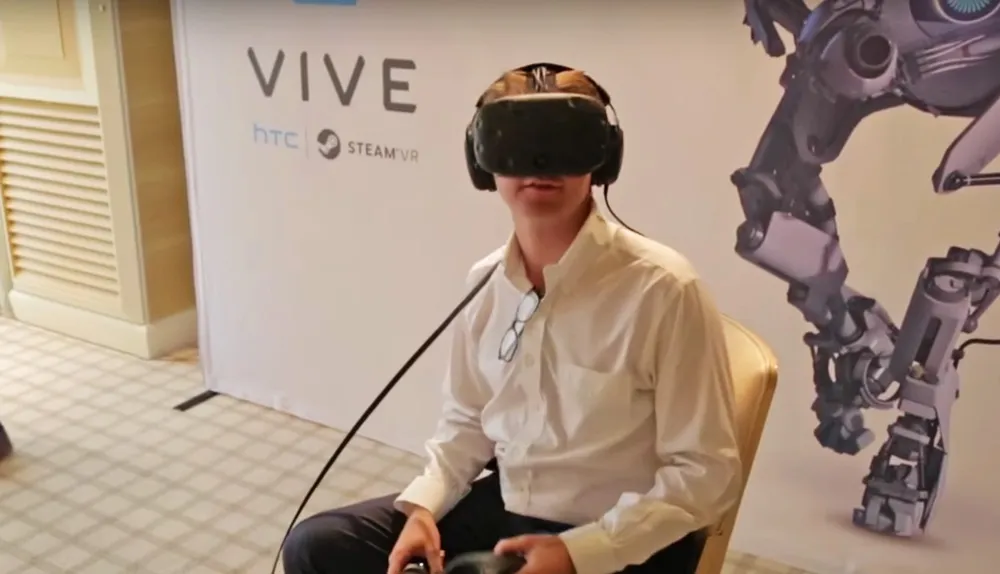I’m staring at the bright blue outline of a chair in front of me with a shadowy blue cushion as an HTC representative beckons me to sit. And I do, with a surprising amount of confidence and ease. I turn to my left and right, I’m in a room full of people and I can make out each one. What’s more, I can tell who’s who in the room with a mix of outline and shadowy facial features. I look over at the cameraman, smile and give him a thumbs up. I’m in a kind of mixed reality with computer vision overlaying the real world on top of my virtual one with the double tap of a button.
When Cher Wang promised “a very, very big technological breakthrough” last month at the Vive Unbound developer conference, this kind “Matrix-vision” I experienced was not necessarily what we hoped for, but it brings with it some interesting potential.
[gfycat data_id=”DisgustingWealthyArmyworm” data_autoplay=true data_controls=false]
“The breakthrough,” says Ryan Hoopingarner, HTC Vive’s Director of Product Marketing, “is really two-fold, it’s really about how you approach the overall user experience.” Part of doing that is making the device both safer and easier to wear. The Vive previously had what is known as the “Chaperone System” allowing the user to set the bounds of their play area. When I approached these bounds a grid would overlay itself on top of the virtual world, giving me an approximate idea of where the walls were.
The new version of this overlays a blue-tinted version of the edges of the real world and shows surfaces of objects outside the play area. It was very effective at making me feel safe walking freely around in my space, and the overlay was translucent enough that I was able to still see the virtual world around me.
Another mode of this pass through could be called up at any point during a VR demo with the double tap of a new button below the trackpad. This would activate a more opaque version of the overlay that took up my entire field of view, allowing me to see things like a chair in the middle of the room or the people around me while also allowing me to still see where I was in the virtual space.

The change is similar to what now Magic Leap Head of Product Marketing, Jeff Gattis, told us about in early September. Except that Gattis suggested a form of active detection (“We want to notify you that an object is moving in front of you, things like that”), something that the HTC Vive Pre doesn’t have, at least not yet.
The addition of a front-facing camera opens the door to “many possibilities” beyond ‘Matrix’ pass through and a better chaperone system. The camera is going to be available to developers with the new SDK, “we are really interested to see what comes from that,” said Hoopingarner. The really cool bit comes when developers start blending AR and VR.
[gfycat data_id=”AmazingGrimLark” data_autoplay=true data_controls=false]
The other half of the breakthrough really comes down to the ergonomics and design of the HTC Vive Pre, which is “redesigned from the ground up,” according to Hoopingarner.
One of the first things you notice about the new HTC Vive Pre is that it looks a lot more like a consumer product than its buggy-eyed predecessor. The second version of the developer kit is significantly smaller (but still somewhat larger than the Oculus Rift) with a more comfortable fit. The redesigned strap is more sturdy and balanced with a familiar-looking triangle design (a design which seems to have seeped into the Vive’s branding). The overall fit is significantly less awkward than the previous developer kit, which was a bit front heavy.

Additionally, the controllers underwent a massive overhaul in both performance and feel. The awkward flimsy octagons that topped the previous controls are replaced by a doughnut shape that blends itself into the controller’s wand. The trackpad and buttons were overhauled for comfort too, with bumps on the ‘grip’ buttons and a rubber pad on the trackpad.

The previous renditions of the wireless controllers occasionally lost tracking “but the great majority of the problems,” says Valve’s Chief Pharologist Alan Yates, “are radio reception related.” This is rectified now, he says, by placing “the controller receivers in the headset,” similar to the Oculus Rift.
Overall the breakthroughs seem to be about making the user experience more seamless and comfortable, consequently leading to people spending more time in VR. Even the new controller’s batteries last “over four hours,” compared to the two to two and a half of the previous kits.
[slideshow_deploy id=’11936′]
Beyond the new camera features and ergonomics, the display was also slightly improved. According to Hoopingarner, the “new brighter display” has a new visual system in place with “improved optics” that add “Mura correction” which HTC Vive Project Manager, Graham Breen says is “basically combining how we use the lenses and the display together to give a far sharper picture.” In my demo, however, the optics felt largely the same if perhaps a little sharper.

The heavy ridges of the HTC Vive’s Fresnel lenses are still clearly visible if you’re looking for them, especially in bright white scenes, like Solfar’s Everest demo, which I had a chance to try. Additionally, when watching scenes with a high amount of contrast, such as white title text on a black background, there is a noticeable amount of light flaring. This was present in the Oculus Rift Crescent Bay demos we’ve seen, but is something that Oculus specifically corrected for in the final version. Neither of these things are dealbreakers, but they do fall into the ‘once you notice them, you can’t not notice them’ category for me.
According to Hoopingarner, the final consumer Vive “may change” between now and launch, and that they would dive deeper into technical specifications “at a later date not too far in the future.”
Overall, the HTC Vive Pre is a big step forward from the previous developer kit. The headset is quite good and where it loses to the Oculus Rift’s consumer version in optics and display, it makes up for with robust tracking and immediate support for hand-tracked controllers (Oculus recently delayed their Touch controllers until the later half of this year). The race between the two headsets is close and ultimately content may end up being the deciding factor for which headset emerges victorious in round one.
More Images:
[slideshow_deploy id=’11948′]



























